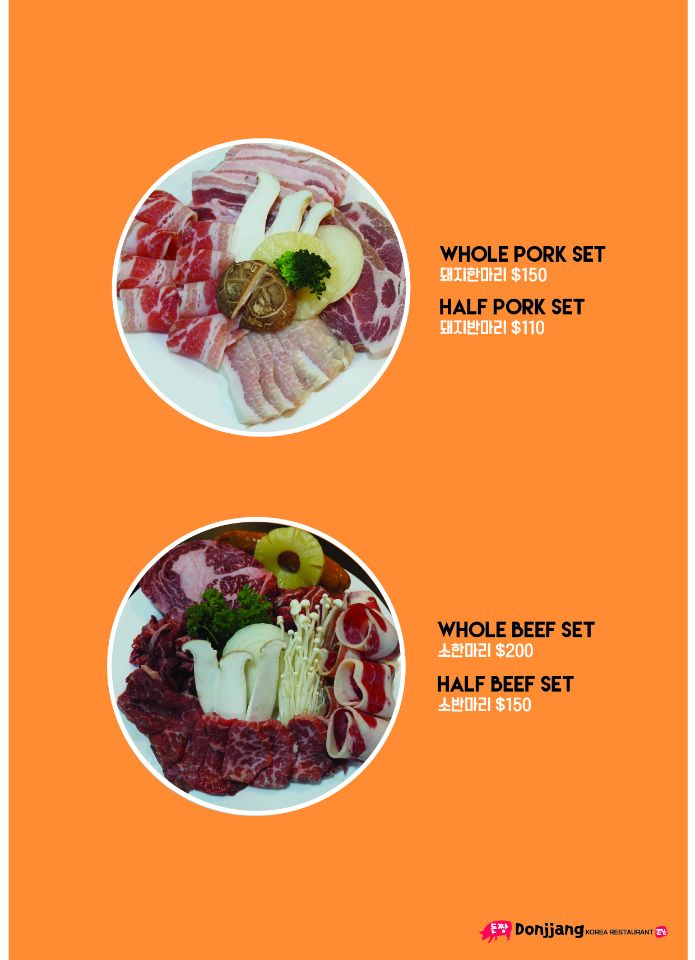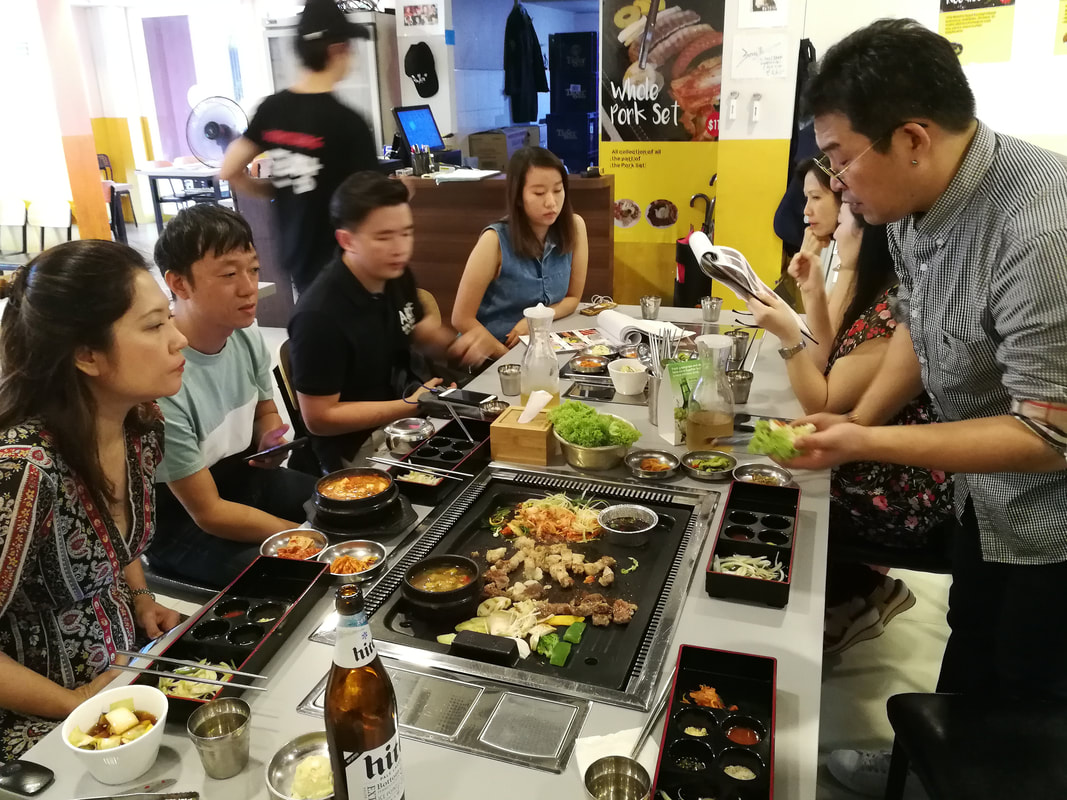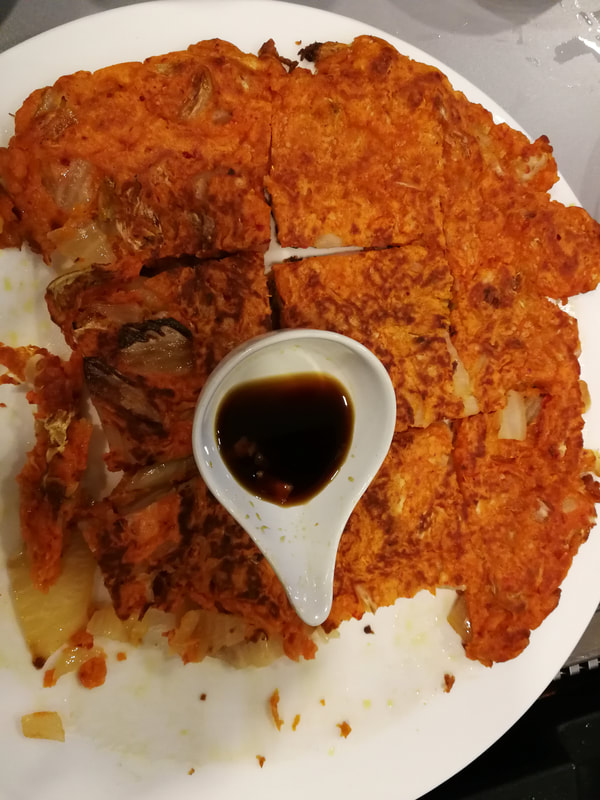Donjjang Korean Restaurant
Spectacular touch to the food &
aesthetically pleasing experience
Spectacular touch to the food &
aesthetically pleasing experience
Donjjang Restaurant is a place which keeps a low profile in the Internet, but is an exciting place to visit if you wish to add a spectacular touch to the food, on top of an aesthetically pleasing experience which also satisfies your taste buds.
I went to Donjjang Korea Restaurant with a group of friends.
The first thing that struck me outside the restaurant was the brightly-lit sign. The words “Donjjang” written in Hangul (the Korean language script) inside the red silhouette of a pig. There was even a sign at the door with a huge pig facing us. On the right window panel, you can see a message written in Korean: “Waste your youth away if you want to, but don’t burn the meat. - Donjjang”
It was obvious that they were proudest of their pork products.
Above the glass door, a video screen showed what the restaurant sold. There was also a small blackboard near the door advertising their latest offers.
I went to Donjjang Korea Restaurant with a group of friends.
The first thing that struck me outside the restaurant was the brightly-lit sign. The words “Donjjang” written in Hangul (the Korean language script) inside the red silhouette of a pig. There was even a sign at the door with a huge pig facing us. On the right window panel, you can see a message written in Korean: “Waste your youth away if you want to, but don’t burn the meat. - Donjjang”
It was obvious that they were proudest of their pork products.
Above the glass door, a video screen showed what the restaurant sold. There was also a small blackboard near the door advertising their latest offers.
Inside the restaurant, I was greeted with the posters and banners of pork dishes. It was obvious that they treated their pork very seriously. Several words were placed on one side of the wall. The message was the same as the one on the window: “Waste your youth away if you want to, but don’t burn the meat. - Donjjang”
However, we didn’t need to worry about burning the meat there. More to come later.
The barbecue grills at the tables were covered by large, rectangular and shiny metal plates, which could be removed if we ordered barbecued meat. There were many baby chairs, ready to be deployed at a moment’s notice, should any customers have children with them. The spare gas canisters were deployed strategically at the centre of the restaurant. It is clear that the restaurant places emphasis on prompt service.
The barbecue grills at the tables were covered by large, rectangular and shiny metal plates, which could be removed if we ordered barbecued meat. There were many baby chairs, ready to be deployed at a moment’s notice, should any customers have children with them. The spare gas canisters were deployed strategically at the centre of the restaurant. It is clear that the restaurant places emphasis on prompt service.
If you haven’t noticed it yet, the restaurant had an elegant white/mustard colour scheme. One must marvel at the details the restaurant took to adopt and maintain its own unique dining experience. If you look closely at the table, you would notice a small, black call button at each table. The service was extremely efficient. When I pressed the button for more water, a waiter would be at our table within a minute.
We looked at the menu. There was a large variety of items to choose from. There were not only menu items for the individual, but also menu items for large groups of people. Here are some pages of their menu.
These were the a la carte dishes on the menu. The servings were meant for one person.
The cutlets looked very good. We ordered the chicken cutlet.
The noodles in the menu looked particularly good, and again, much effort was taken to make the noodles look aesthetically appetising. Notice the light-coloured garnishings used to brighten up the appearance of the buckwheat noodles.
On the page entitled “Special Dishes”, the army stew looked particularly appetising.
Despite the attempts of these appetising dishes to steal the show, the huge silver plates on our tables and the “Don’t Burn the Meat” warning on the restaurant wall helped influence our decision to look at the BBQ meat the restaurant had to offer.
The BBQ beef was sold in many different forms, as shown above.
The BBQ pork in the menu served the popular pork belly and several other cuts.
For large groups of people who couldn’t decide which cuts to choose from, the restaurant offers a choice of pork sets and beef sets to choose from. For either types of meat, you can choose either a whole set or half set.
Notice the garnishings of mushrooms, pineapple slices and broccoli, which add a touch of colour and elegance to the bright red and pink cuts of meat.
These were the a la carte dishes on the menu. The servings were meant for one person.
The cutlets looked very good. We ordered the chicken cutlet.
The noodles in the menu looked particularly good, and again, much effort was taken to make the noodles look aesthetically appetising. Notice the light-coloured garnishings used to brighten up the appearance of the buckwheat noodles.
On the page entitled “Special Dishes”, the army stew looked particularly appetising.
Despite the attempts of these appetising dishes to steal the show, the huge silver plates on our tables and the “Don’t Burn the Meat” warning on the restaurant wall helped influence our decision to look at the BBQ meat the restaurant had to offer.
The BBQ beef was sold in many different forms, as shown above.
The BBQ pork in the menu served the popular pork belly and several other cuts.
For large groups of people who couldn’t decide which cuts to choose from, the restaurant offers a choice of pork sets and beef sets to choose from. For either types of meat, you can choose either a whole set or half set.
Notice the garnishings of mushrooms, pineapple slices and broccoli, which add a touch of colour and elegance to the bright red and pink cuts of meat.
We ordered a chicken cutlet, a beoljip pork belly and a kimchi pancake.
When the silver plates were removed, the grill plate looked as follows. The surface was flat and large, allowing a large amount of stuff to be barbecued at the same time.
Each diner was provided with a personal food tray. The left compartment was empty, to put my food. The right compartment contained a generous amount of sliced onions.
When the silver plates were removed, the grill plate looked as follows. The surface was flat and large, allowing a large amount of stuff to be barbecued at the same time.
Each diner was provided with a personal food tray. The left compartment was empty, to put my food. The right compartment contained a generous amount of sliced onions.
There were four round compartments in the middle, each containing different condiments.
Condiments (clockwise from top left): Sea salt, roast grain powder, ssamjang and sesame oil (a mixture of doenjang and gochujang)
The beoljip pork belly we ordered arrived in less than five minutes. Beoljip means that shallow cuts are made into the pork belly before it is barbecued. You can see the cut lines on the surface of the pork belly. There is a sprinkling of black pepper and salt on the surface of the meat.
Condiments (clockwise from top left): Sea salt, roast grain powder, ssamjang and sesame oil (a mixture of doenjang and gochujang)
The beoljip pork belly we ordered arrived in less than five minutes. Beoljip means that shallow cuts are made into the pork belly before it is barbecued. You can see the cut lines on the surface of the pork belly. There is a sprinkling of black pepper and salt on the surface of the meat.
A small serving of vegetables accompanied the pork belly. I was particularly fascinated by the pineapple slice because it was the only fruit on the plate.
Lush, green leaves of cabbage came with the pork belly. The Koreans wrap the barbecued pork in the cabbage before eating it. These vegetables could be topped up upon request. I found the vegetables so crunchy and fresh that I ate them alone without the meat alone.
Lush, green leaves of cabbage came with the pork belly. The Koreans wrap the barbecued pork in the cabbage before eating it. These vegetables could be topped up upon request. I found the vegetables so crunchy and fresh that I ate them alone without the meat alone.
For any Korean restaurant, there is always a free flow of banjjang (side dishes). This restaurant’s banjjang contains six dishes (clockwise from top left): Anchovies, radish, kimchi, vegetables, Korean fishcake and mashed potato.
We also ordered doenjang-jjigae (or soybean paste stew). It came ahead of the pork. The waiter set it down on the large black BBQ plate, which meant that the stew would be kept nice and warm.
We also ordered doenjang-jjigae (or soybean paste stew). It came ahead of the pork. The waiter set it down on the large black BBQ plate, which meant that the stew would be kept nice and warm.
The restaurant staff patrolled the restaurant diligently. They were equipped with hand-held thermometers and used them to measure the temperature of the BBQ plate.
Not long after temperature of the BBQ plate had reached its desired temperature, the meat, vegetables and the kimchi went onto the plate.
The fragrant smell of the meat, coupled with the sharp scent of kimchi and the soyabean paste stew, combined to form a smell that made us want to clear the table. However, there was still more to come.
The restaurant staff came to our table and poured some clear liquid from a vodka bottle over the meat. I don’t think it’s vodka; it was more likely to be some kind of cooking oil.
What happened after the liquid was added to the meat?
Not long after temperature of the BBQ plate had reached its desired temperature, the meat, vegetables and the kimchi went onto the plate.
The fragrant smell of the meat, coupled with the sharp scent of kimchi and the soyabean paste stew, combined to form a smell that made us want to clear the table. However, there was still more to come.
The restaurant staff came to our table and poured some clear liquid from a vodka bottle over the meat. I don’t think it’s vodka; it was more likely to be some kind of cooking oil.
What happened after the liquid was added to the meat?
Flames leapt out of the meat immediately. It was very dramatic. I was worried that the stew and vegetables would catch fire. They didn’t. Upon doing some research on the Internet, I found out that it was a by-effect of cooking the meat at a higher-than-normal temperature, used to make the meat even more tasty than it already was.
After the flames had subsided and then vanished, I was surprised that the meat still looked very pale. The vegetables and dishes around the meat didn’t look damaged either. I was filled with admiration for the chef’s ability to create the dramatic effect of having fire leap out of the stove without anything (or anyone!) getting burnt.
The staff proceeded to serve the meat to us, Korean-style. A slice of pork was wrapped in cabbage and served to each of us.
After the flames had subsided and then vanished, I was surprised that the meat still looked very pale. The vegetables and dishes around the meat didn’t look damaged either. I was filled with admiration for the chef’s ability to create the dramatic effect of having fire leap out of the stove without anything (or anyone!) getting burnt.
The staff proceeded to serve the meat to us, Korean-style. A slice of pork was wrapped in cabbage and served to each of us.
When I took a bite out of the meat, I was surprised at how fresh the vegetable were. They were as crisp as potato chips! The meat inside was extremely tender. If you made a bed made out of pork cooked like this, a block of wood dropped on it would bounce.
Next, came the chicken cutlet. Notice the generous portion of meat and salad. For people who are health-conscious, this dish would not be a guilt trip. The chicken cutlet itself was caked in a generous layer of dressing, and the potato wedges were taste, but there was no taste of grease. There was a small serving of rice or baked beans, which provided a welcome contrast to the rich taste of the chicken cutlet and the gravy. Finally, to add a welcome dose of colour, there was a generous serving of crunchy vegetables and tomato slices as a side dish. Interestingly, there was a slice of pineapple and a sprinkling of mushrooms on top of the cutlet.
The chicken cutlet was thick and juicy. The sweetness of the gravy was a nice touch to the cutlet, and there was little to no trace of oil in the chicken at all.
Next, came the chicken cutlet. Notice the generous portion of meat and salad. For people who are health-conscious, this dish would not be a guilt trip. The chicken cutlet itself was caked in a generous layer of dressing, and the potato wedges were taste, but there was no taste of grease. There was a small serving of rice or baked beans, which provided a welcome contrast to the rich taste of the chicken cutlet and the gravy. Finally, to add a welcome dose of colour, there was a generous serving of crunchy vegetables and tomato slices as a side dish. Interestingly, there was a slice of pineapple and a sprinkling of mushrooms on top of the cutlet.
The chicken cutlet was thick and juicy. The sweetness of the gravy was a nice touch to the cutlet, and there was little to no trace of oil in the chicken at all.
The bean paste soup was rich and thick, and offered a welcome contrast to the cutlet and pork. It may have been spicy, given the red and green chillies present inside, but the serving was just right – too big a bowl and it would have been a case of having too much of a good thing. I was able to finish the bowl without any problems, even though I am averse to spicy food.
The restaurant staff served a complimentary dish for us: localised kimchi.
This was not the traditional kind of kimchi, red all over. It contained cabbage, but the cabbage was pale green, and it also contained cucumber and carrot slices. From the colour alone, it was easy to mistake it as a kind of soup from any other Chinese shop, but upon tasting it, I found that it was still recognisable as a form of kimchi. Yet, the taste of the cabbage, cucumbers and carrots in the soup provided a sense of familiarity. It would be nice to see it as one of their promotions some day.
To round it all off, we also ordered kimchi pancake.
The restaurant staff served a complimentary dish for us: localised kimchi.
This was not the traditional kind of kimchi, red all over. It contained cabbage, but the cabbage was pale green, and it also contained cucumber and carrot slices. From the colour alone, it was easy to mistake it as a kind of soup from any other Chinese shop, but upon tasting it, I found that it was still recognisable as a form of kimchi. Yet, the taste of the cabbage, cucumbers and carrots in the soup provided a sense of familiarity. It would be nice to see it as one of their promotions some day.
To round it all off, we also ordered kimchi pancake.
The kimchi pancake is a traditional Korean dish, and it isn’t easy to make it look better, so the staff placed the white saucer containing the condiments on top of the plate. I was impressed by the level of detail the staff took into their presentation. No stone was left unturned in making the diners have a pleasant experience in terms of taste. They also went the extra mile in making sure that each dish was aesthetically pleasing when served.
All in all, the four dishes I had with my friends was well worth the price we paid ($164). Divided between six people, it came up to around $27, a reasonable price for a restaurant where the staff took the effort in making sure that the diners’ taste buds had been satisfied, but was able to add an aesthetically pleasing experience on top of it. The moment where the kitchen staff set the hot plate on fire added a touch of excitement to the entire culinary experience.
I’ll be sure to go for the assorted pork cuts when going out with my friends in future.
Donjjang Korean Restaurant
Address : 33 Mohamed Sultan Rd, Singapore 238977
All in all, the four dishes I had with my friends was well worth the price we paid ($164). Divided between six people, it came up to around $27, a reasonable price for a restaurant where the staff took the effort in making sure that the diners’ taste buds had been satisfied, but was able to add an aesthetically pleasing experience on top of it. The moment where the kitchen staff set the hot plate on fire added a touch of excitement to the entire culinary experience.
I’ll be sure to go for the assorted pork cuts when going out with my friends in future.
Donjjang Korean Restaurant
Address : 33 Mohamed Sultan Rd, Singapore 238977







